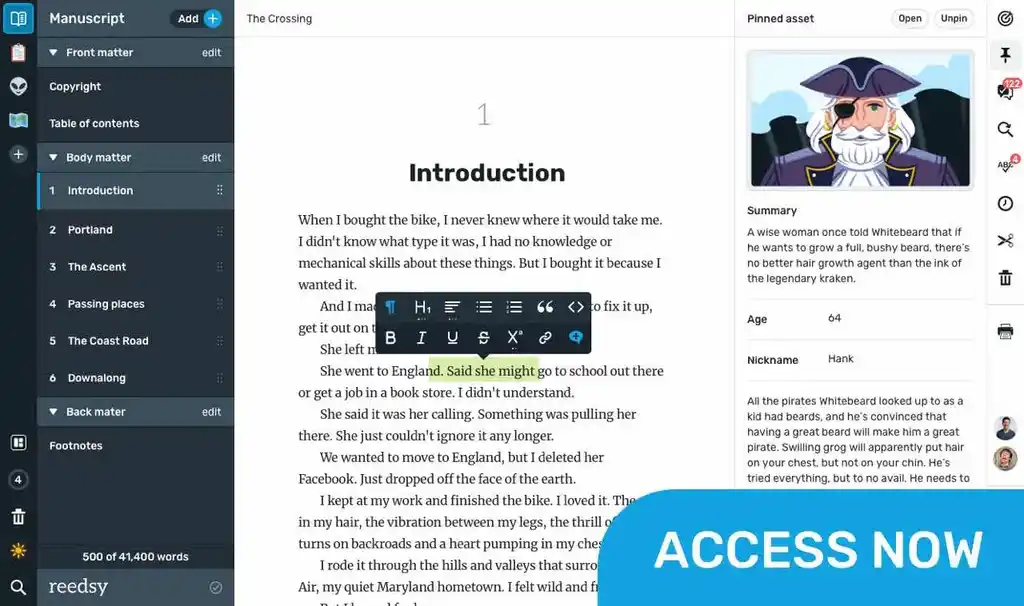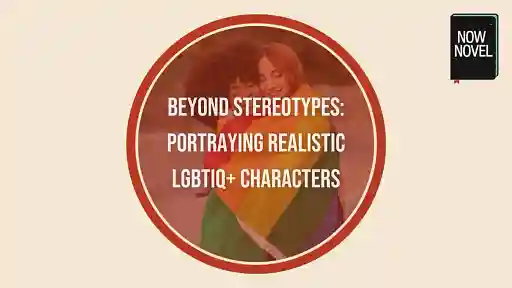Does your story containing female characters pass the Bechdel test? Never heard of it? Simply put the Bechdel test is a way of evaluating whether or not a film or any other work of fiction portrays women in a way that is sexist or characterized by gender stereotyping. To pass the Bechdel test a work must feature at least two women, these women must talk to each other and their conversation must concern something other than a man.
In this post we look at how to make sure you pass that Bechdel test by writing well-developed female characters, rounded, believable, ones that are believable and resonate with your readers. We’ll also look at excerpts from novels that feature such characters.
What is a well-developed female character?
Firstly, just what is a well-developed female character?
She’s there to play a significant role in the story. She isn’t there to prop up a man or serve his whims and desires. Many of the women in the James Bond franchise spring to mind here: somewhat cardboard characters, while they play a role in the plot, they are also really there to make sure Bond has someone to bed.
Make sure that your character isn’t just a passive participant. Give her goals and a backstory so that we get to know her better. Her motivations should be clear and personal, not just related to male characters or romantic interests. These goals will drive the narrative, and keep readers invested in following her journey.

Backstory
Take time to introduce her through her back story. What made her the kind of women she is today. Explore her background: her background, the family she came from, where she studied (or didn’t). How have these influences shaped her views on life, relationships, having children (or not)? What relationships does she have with others in her life – her parents, friends, other family members? If she is an only child, she may be strong and independent, add this flavour to your well-developed female character. Perhaps she came from a large family of five siblings, and this means she struggles with being alone. This could mean that she falls into unsuitable relationships with others (a partner or other friendships) to avoid being alone. Consider how this influences the plot line: it may even be the driving force.
Consider her place in the world
Consider her place in the world of your story. Think about the societal norms and gender expectations in that milieu. A woman in Victorian times has to conform in different ways to a woman in contemporary times, or the back-to-the-home conservative 1950s. How do they affect her behavior, opportunities and interactions with others?
A good example of three types of women from different social contexts is found in Michael Cunningham’s The Hours. The Virginia Woolf of the 1920s is living a life where she can write experimental novels and break new ground in literature. Contrast this with the 1949 Los Angeles housewife Laura Brown, pregnant with her second child, who struggles with her prescribed role in life. Contrast this further with Clarissa Vaughn of the present day, a lesbian who is able to live a freer, more independent and open life.
If a character breaks the norms and conventions of her time, then show the challenges and consequences she faces, as well as her reasons for doing so.
Strengths and flaws
Bottom line: a well-developed character has a mix of strengths and flaws. Don’t make her a flawless Madonna serving the needs of her family with a smile on her face, such a character sounds boring and passive. Similarly, a tough as nails character, while interesting, should have vulnerabilities, too. As with women in real life, a female character should reflect many facets of personality traits. Give her a range of emotional hues: while a strong character might plunge headlong into her job, for example, ambitious, driven and fuelled by her passion for it, make her cry in sad movies, show her softer, more vulnerable side.
Avoid stereotypes
There’s a wonderful meme that pops up on social media from time to time. It shows a painting of a woman reading: except her gown has fallen from her breasts, and she’s reading topless. The writing on the meme is something along the lines of: my dress just happens to fall off my breasts when I am reading. Yeah, right.
No, women do not go about with their breasts exposed as they read, and this meme pokes fun at the typical male gaze. This is characterized by a tendency to objectify or sexualize women. Yes, women are sexual creatures, as much as men are, but their complexity hinges on the fact that they are not just sexual beings, they are not only young and beautiful. So avoid writing them as such. Avoid that ‘male gaze’ way of portraying a woman – and this goes for whatever gender you are.
To take this a little further: avoid reducing her to her looks. While your readers want to know what your character looks like, describe her appearance realistically and only when it’s relevant. Avoid focusing excessively on her physical attributes unless it serves a purpose in the story. Emphasize her internal qualities, skills and actions over her appearance. Don’t let her appearance overshadow her personality, intelligence, or abilities.

Avoid the cardboard cut-out character definition
Avoid the cardboard cut-out character definition: don’t rely on clichés like the damsel in distress, the femme fatale or the nurturing mother. If your character sounds like a cartoon character with a feature-less face, give her a wrinkle or two, so to speak.
Do your research. It may be obvious that you would research an historical time period, for example, but if you’re a man writing about a woman, for example, try not to assume you know women simply because you’re married to one. Ask what it’s like to have period pains or give birth. Ask a woman what she sees when she looks in a mirror. Ask her what she thinks about when she thinks of the future. Ask her what her best time of her life was: perhaps she feels like it has already occurred. Perhaps she replies that she’s still waiting.
Similarly, a female writer might feel well equipped to write about other women, but again, we all come from a particular race or class, with our own biases and prejudices. If you’re a middle-class white writer wanting to write the character of an Indian woman, you will need to do some research. Interviews are a wonderful way of getting inside other people’s minds, and if you say that you are writing a novel and would like to conduct an interview, you’re likely to find some willing participants. Just make sure that you guarantee anonymity! If your character is a woman of color, LGBTQ+, disabled or belongs to another marginalized group, consider how these aspects of her identity intersect and affect her experiences and worldview.
Read books, see films with strong female characters
Seek out and read books with strong female characters, watch films, TV shows and documentaries showing well-developed female characters. Take notes on how these characters are written, how they are introduced, how they speak. Men and women do speak differently: explore this, read up on this too. Go further and look for analyses or essays on female characters in fiction. Study feminist literary criticism and gender theory. This can help you understand how female characters have historically been portrayed and how to avoid stereotypes or clichés.
If possible, get feedback from women or sensitivity readers, especially if you’re writing outside your own experience. They can offer valuable insights and help you avoid those unintentional biases or inaccuracies.
Examples of well-developed female characters
Let’s turn to some portrays of women in literature.
Celie in The Color Purple
Celie in The Color Purple by Alice Walker starts out her life as a dirt-poor woman in the early years of the 20th century. She gives birth to two children by her father, and is soon barren and married off to the mean-spirited Mr___ who abuses her physically and emotionally. Her strong character comes through in the novel, despite her abuse and her lack of agency. The book is composed of her ‘letters to God’, and from the opening pages we are hooked.
‘I ast him to take me instead of Nettie while our new mammy sick. But he just ast me what I’m talking bout. I tell him I can fix myself up for him. I duck into my room and come out wearing horsehair, feathers, and a pair of our new mammy high heel shoes. He beat me for dressing trampy but he do it to me anyway.'
Later on in the novel, we get a sense of what Celie looks like as seen through the eyes of Mr ___:
‘You’ll be back, he say. Nothing up North for nobody like you. Shug got talent, he say. She can sing. She got spunk, he say. She can talk to anybody. Shug got looks, he say. She can stand up and be notice. But what you got? You ugly. You skinny. You shape funny. You too scared to open your mouth to people.’
Ultimately, Celie comes out on top, the hints of her strength as shown in the beginning of the book come to the fore through her life, and propel her out of her abusive circumstances.
Ruth Galloway in The Crossing Places
Proving that not all women in fiction have to be beautiful, young and thin, Elly Griffiths has this description of her detective, Ruth Galloway in The Crossing Places:
‘Ruth rubs herself vigorously with a towel and stares unseeingly into the steamy mirror. She knows what she will see and the knowledge is no more comforting than her parents’ prayers. Shoulder-length brown hair, blue eyes, pale skin – and however she stands on the scales, which are at present banished to the broom cupboard – she weighs twelve and a half stone. She sighs (I am not defined by my weight, fat is a state of mind) and squeezes toothpaste onto her brush. She has a very beautiful smile, but she isn’t smiling now and so this too is low on the list of comforts. …She used to wear jeans until she hit size sixteen and now favours cords, black, of course. Jeans are too young for her anyhow. She will be forty next year.
Lesley Hamlyn in The House of Doors
In The House of Doors Tan Twan Eng inserts the writer W. Somerset Maugham into the fictional lives creates Lesley Hamlyn and her husband, Robert, a lawyer and war veteran, living at Cassowary House on the Straits Settlement of Penang in 1921. He creates a nuanced portrait of Lesley, and the story is filtered through her experiences. While constrained by the times she lives in, and what is expected of women, she still has agency and makes a choice in the novel that shows that agency. Here is Somerset Maugham observing her:
Keeping his body completely still, Willie studied her. Lesley’s hair was a pale blond, falling down to an inch or two above her shoulders. The sunlight sculpted out her sharp cheekbones. The climate had not sagged her skin or smudged the line of her jaw, but fine lines sprouted from the outer edges of her deep-set eyes, which were the colour of old tea. The corners of her mouth were slightly curled, pulled downwards by another tangle of lines, giving them an anatine look.
‘Not a great beauty, Willie had decided when he first met her yesterday afternoon, and now confirmed it to himself again; nevertheless, her face had a compelling, doleful quality.’

Meet top editors, designers, and marketers
The best professionals are already on Reedsy. Sign up now to request free quotes.
Isabel in Day
To return to another of novel by Michael Cunningham, Day, let’s take a look at Isabel, a mother and one of the central characters in this multi-character novel. In a few brushstrokes, Cunningham paints a portrait of a woman obliquely glimpsed, sometimes poised between what she desires and what she has:
‘She’s sometimes only semi-identifiable to herself, in photographs. She has, since childhood, been trying to catch glimpses of her authentic, immutable self.
Isabel envisions herself sitting here on the stairs for years to come. She could be a figure in a European movie: the Woman on the Stairs. A woman paralyzed by her own selfishness and triviality, a woman who knew she should love her life more than she did but couldn’t seem to love her life beyond a few odd inconsequential incidents. She’s seen an owl where there could not reasonably have been an owl and, knowing that owls must symbolize some sort of misfortune—screech and talons descending from what had seemed a balmy night sky—has found that she can go neither up nor down the stairs. And so, here she is.
She’d remain here, indifferent to all pleas and exhortations. She’d be here as her children grew older, as they learned to pass her on their way to and from home with a quick Good morning, Momma or Good night, Momma. ‘It has, until recently, seemed reasonable for her to anticipate more, because there was more to be had. Now she’s like the woman in the fairy tale who demands more wishes from the magic fish, more and more, until the fish grows weary of her and takes it all away.’
For more examples of strong female characters have a read of this list by Masterclass which includes Katniss Everdeen in Suzanne Collins’ The Hunger Games and Hermione Granger in J. K. Rowling’s Harry Potter series. For yet more examples, check out this range of female characters.
For more on characterization read our blog post on ways your characters can change and how to write people, not caricatures. Lastly, take a look at our complete guide to creating characters.









